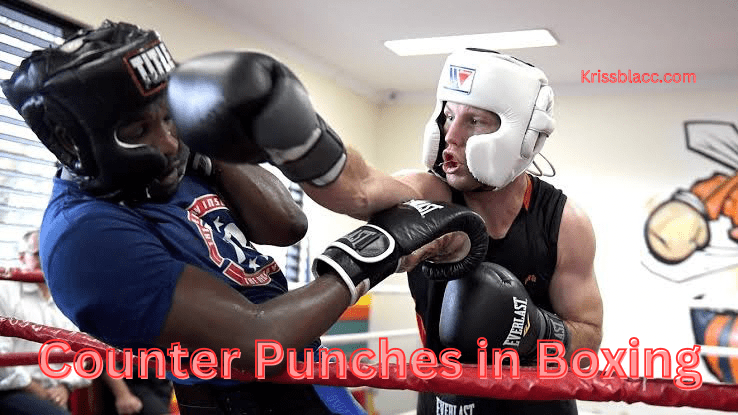Counterpunch is a special and effective punch in boxing under the condition of meeting an opponent’s attack with a blow executed at a quicker tempo.
True counterpunch is a method of converting the opponent’s aggressive actions into scoring threats and substantially enhancing your protection plan together with your attacking reach.
This article focuses on the general understanding of counter punch which includes general techniques and complex techniques that can be applied in boxing.
Understanding Counter Punching
Counterpunching essentially involves observation, speed, and most importantly good timing. It entails being able to wait for your opponent to offer an opportunity and then set in a punch once they are weak.
This technique is quite efficient because it capitalizes and takes advantage of an opponent’s vulnerable exposed state when they throw a punch.
Benefits of Counter Punching
- Defensive Advantage: Counterpunching can be used in a fight to keep one on the defensive side while at the same time looking for an opening to attack. They limit your vulnerability to harm and place your competitor on the back foot when the puck is being passed.
- Psychological Edge: It is often effective in putting pressure on your opponent and making him/her defensive, thus reducing the number of shots he/she can throw.
- Energy Conservation: While counterpunching is somewhat less energy-consuming than constant attempts at aggression, one can save his strength for further rounds.
Key Principles of Effective Counter-Punching
- Timing and Precision: In essence, the set-up applied in a counter punch aims at creating a precise and accurate shot to penetrate successfully. The punch has to be thrown when your opponent is attacking or right after they have thrown their punch.
- Observation and Anticipation: There is hardly anything that defines counterpunchers as far as the success of executing a punch is concerned; however, one thing that plays an important role in the contract of counter punching, is the ability of the counter puncher to anticipate the moves as the opponent approaches with a punch. This means you have to pay attention at all times and know and anticipate the moves of the competitor.
- Positioning: stance and distance are key factors that confront counter-punching irrespective of the fighter’s level of expertise. You have to be in range to counter-punch but far enough for your opponent not to land a punch on you.
Techniques for Counter Punching
Some punches and defensive moves typically can be executed and serve as counters to the opponent’s successful punches. Here are some fundamental techniques: Here are some fundamental techniques:
Slip and Counter
- Slip and Jab: If your opponent extends his/her right arm making a hook, duck to the left (if your opponent is orthodox) and counter with your jab. It enables you to slip out of the way of the punch and get your counter-punch in while the opponent is still opening himself up.
- Slip and Cross: Slide to the outside of your opponent’s jab and then counter with the straight cross. This punch can be even stronger and deliver a better impact if done at the right time.
Parry and Counter
- Parry and Jab: Move your head slightly to the side block the incoming jab with your left-hand punches back, and then throw your jab. This technique simply stops the flow of the opponent’s attack and puts them in a vulnerable state for a counter.
- Parry and Hook: Slip an incoming jab or cross with your left and counter with a left hook. This punch can hit an opponent when he or she is least expecting it, especially when one is focused on delivering the first punch.
Block and Counter
- Block and Cross: Parry your opponent’s hook with your left hand and follow up with the right cross. This technique enables one to take a hit and fire a punch back.
- Block and Uppercut: Parry an incoming uppercut or hook with the glove or the forearm and retaliate with an uppercut. They were noting that this punch can be effectively delivered at short range only.
Pull and Counter
- Pull and Jab: Twist your body back a little to avoid an attack from your opponent and then step forward and throw a punch. In this technique, the performer relies on the force of movement of the opponent’s body to bolster the power of the counter-punch.
- Pull and Cross: Similar to the pull and jab, step back to avoid the punch then at the same time throw a cross punch. This movement can build up quite a powerful counter that the opponent can hardly be prepared for.
Premier Tactics for Countering
The proficient counterpuncher can execute advanced tactics that enable him to effectively neutralize an opponent’s offense.
Feints and Traps
- Feinting: About feints: It should also be remembered that feints should be employed to make the adversary deliver a punch. If they respond do it with equal force. Feinting can make your opponent move in a way that you would want him to and get him to leave his counterpunches open.
- Setting Traps: On purpose avoid employing certain aspects of your defense to entrap your opponent to throw a specific blow. Always be ready for a response when they proceed to go on the attack.
Combining Counter Punches
- Combination Counters: Rather than throwing just single counter punches go for the combo part of it. For instance, one can slip and counter with the jab and then the cross and the hook. It opens your opponent up for more hits and generally makes it hard for the opponent to read your punches making the combinations even more useful.
- Countering Combinations: Be one step ahead of your adversary and counter in your sequence while your adversary is building their sequence. This takes time and demands the ability to dodge and the knowledge of basic punches.
Movement and Angles
- Angling Off: In response, after hitting an opponent with a counter punch, one should turn to have a different stance. Now you are out of the bullets’ range, and new possibilities of counterattacks appear.
- Lateral Movement: Sweep side to side to dodge punch attacks and get into positions to counter them with. Moving side-to-side can, therefore, upset the opponent’s rhythm and timing and gain the opportunity of counterpunches
Frequently Asked Questions
What is it about counterpunching that makes it crucial in boxing?
Counterattacking is critical because it enables you to make a good out of your opponent’s mistake since it focuses on exploiting the fault of the aggressor. It incorporates the dreaming and the waking, which are a good method of handling a struggle.
What advice can I receive for counterpunching?
To increase the effectiveness of counter punchers follow certain base drills that comprise of timing, accuracy, and anticipation. Engaging with partners, who pretend to have various pacing and grooving patterns also makes it easier to influence your counter-punching patterns.
What mistakes can be made while performing the counter-punching strategy?
Some of the mistakes people make are wrong timing, vagueness, and over-signaling your moves. This should be done by remaining as calm as possible, paying close attention to the opponent’s signals, and rehearsing reactions in a sparing environment.
To what extent is it possible to counterpunch any kind of an opponent?
Indeed, counterpunching is possible to be used against any kind of opponent. However, it is especially effective against the fighters who tend to attack more often since it makes use of their charge and leaves them vulnerable.
Who are some of the famous boxers that are prominent in counterpunching?
The modern types of counterpunchers are Floyd Mayweather Jr., Juan Manuel Marquez, and James Toney. It is an efficient way to learn how to counterattack since the fights present so many tactics that the parties employ.
Conclusion
counter-punching in boxing entails several elements such as skill, strategies, and constant training.
With the help of the principles, familiarization with several techniques, and integration of improved strategies, you can improve your skills in using counterpunches and get more benefits in the ring.


